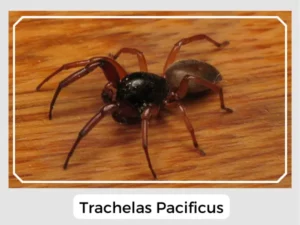Trachelas pacificus is a special kind of spider that lives in North America. It’s part of the ground sac spiders family. Discover interesting facts about this spider right here.

Photo Credit: Michael Schmidt
Females lay around 26 eggs inside a white, papery silk-like, flat-bottomed sac made of webbing. Each egg is approximately 9 cm long.
The juveniles resemble tiny adults.
As a wandering hunter, this species does not use webbing to catch prey.
Yes, Trachelas pacificus spiders have venom, like most spiders, which they use mainly to immobilize their prey.
Yes, Trachelas pacificus spiders can bite, but they usually do so only when they feel threatened. Their bite is not considered dangerous to humans.
Trachelas pacificus spiders play an essential role in controlling insect populations, particularly in vineyards where they are commonly found. Their presence helps maintain a balance in the ecosystem by reducing the number of harmful insects that can damage crops.
Natural Predator: Natural predators of Trachelas pacificus include birds and larger insects, which help regulate their population and maintain a natural balance in their habitats.
Prey-Predator Dynamics: These spiders are effective predators of smaller insects, thus contributing to the ecological equilibrium. At the same time, they serve as prey to larger species, highlighting their role in the food chain.
Relationship with Humans: Interaction between Trachelas pacificus spiders and humans is minimal and typically harmless. While they possess venom and are capable of biting, such incidents are rare and not harmful to humans.
| Lifespan | 1-2 years |
| Distribution | Mexico and the United States |
| Habitat | Vineyards, mainly grapes |
| Diet | Insects |
In summary, Trachelas pacificus spiders are not only fascinating due to their unique physical characteristics but also play a crucial ecological role in their natural habitats.
Trachelas pacificus is a special kind of spider that lives in North America. It’s part of the ground sac spiders family. Discover interesting facts about this spider right here.

Photo Credit: Michael Schmidt
Females lay around 26 eggs inside a white, papery silk-like, flat-bottomed sac made of webbing. Each egg is approximately 9 cm long.
The juveniles resemble tiny adults.
As a wandering hunter, this species does not use webbing to catch prey.
Yes, Trachelas pacificus spiders have venom, like most spiders, which they use mainly to immobilize their prey.
Yes, Trachelas pacificus spiders can bite, but they usually do so only when they feel threatened. Their bite is not considered dangerous to humans.
Trachelas pacificus spiders play an essential role in controlling insect populations, particularly in vineyards where they are commonly found. Their presence helps maintain a balance in the ecosystem by reducing the number of harmful insects that can damage crops.
Natural Predator: Natural predators of Trachelas pacificus include birds and larger insects, which help regulate their population and maintain a natural balance in their habitats.
Prey-Predator Dynamics: These spiders are effective predators of smaller insects, thus contributing to the ecological equilibrium. At the same time, they serve as prey to larger species, highlighting their role in the food chain.
Relationship with Humans: Interaction between Trachelas pacificus spiders and humans is minimal and typically harmless. While they possess venom and are capable of biting, such incidents are rare and not harmful to humans.
| Lifespan | 1-2 years |
| Distribution | Mexico and the United States |
| Habitat | Vineyards, mainly grapes |
| Diet | Insects |
In summary, Trachelas pacificus spiders are not only fascinating due to their unique physical characteristics but also play a crucial ecological role in their natural habitats.